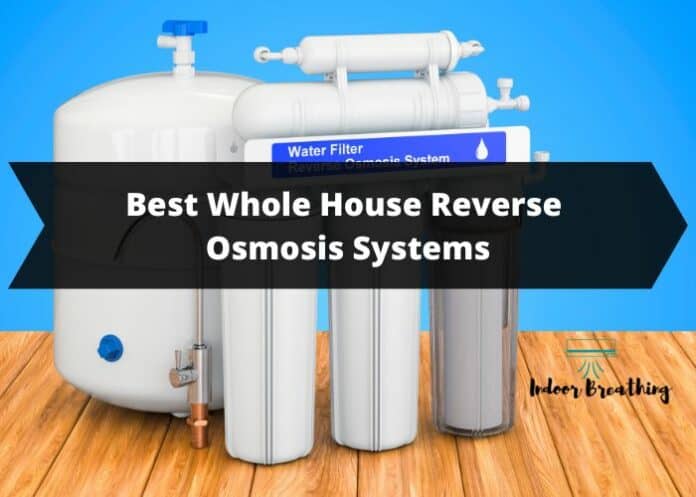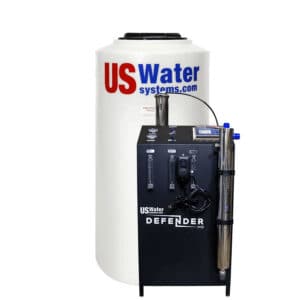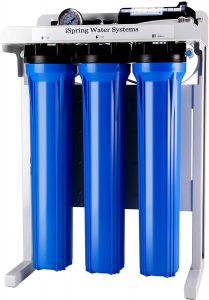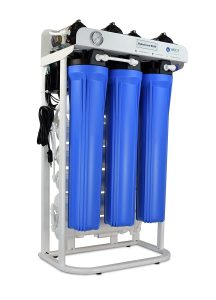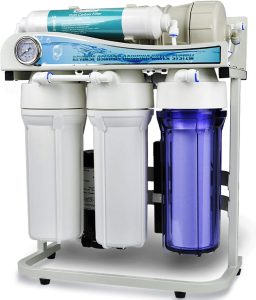One can find various water filtration systems out there in the market. But not all of these filters remove total dissolved solids or TDS.
Reverse Osmosis is regarded as one of the most effective forms of filtration that can efficiently reduce the total dissolved solids by more than 99.9%. The reduction of these solids would lead to virtually pure water.
The most common type of reverse osmosis system has been designed to improve the quality of drinking water.
The increase in demand for reverse Osmosis systems has led to a significant increase in the products made available for the treatment market.
Therefore, if anyone is interested in purchasing a reverse osmosis system that provides sufficient purified water, they should get a guide like this.
Table of Contents
Best Whole Reverse Osmosis Systems
1. Best Overall: Crystal Quest Whole House Reverse Osmosis System
The Crystal Quest Whole House Reverse Osmosis System is considered a high-performing, great-value whole house that reverses the osmosis system. It can efficiently provide clean and purified water throughout the entire home of a person.
Made in the USA, this crystal quest system goes through extensive tests before being delivered to customers. This fully equipped reverse osmosis system can assure customers that they will get water of exceptional quality from the beginning.
Customers can use this system for up to fifteen or twenty years if they follow the instructions of their suppliers. This system can be operated through 9 different flow rates.
These water flows are effective in suiting any home’s water pressure. Although this system is naturally bulkier, it has a space-saving feature.
The various components needed for the proper functioning this system are easily accessible. Besides, the costs involved in running this system are relatively low as it is an economical option.
Moreover, the crystal Quest Whole House Reverse Osmosis System is certified by ISO.
Pros
- One of the most economical options for home RO systems.
- Large tank for storing water.
- Different flow rates to choose from.
Cons
- Relatively new system, so fewer customer reviews.
2. Runner-Up: US Water Systems Defender Whole House RO System
The defender is one of the most durable options for a customizable whole-house Osmosis system. This system can efficiently provide clean water to the property of any person.
Built-in the USA, the entire defender system can be used for both at-home and commercial applications. The high-quality components present in this system include stainless steel housings.
Besides, the users would get a two-year warranty on this product with a good lifespan.
According to several experts, the defender has an efficiency rate of almost 80%. This also means the system would waste just one gallon of water and produce five gallons of purified water.
In addition, a commercial Centrifugal pump in the defender gives it a higher lifespan than other RO systems.
This system’s flow meter and pressure gauge can control water and wastewater production. Most manufacturers prefer their customers the pre-treatment that helps in increasing the lifespan to almost twenty years.
The way to replace the filters in the Defender is easy but should be done after consultation with the manufacturer. The Defender can reject up to 99%TDS.
Pros
- 80% efficiency rate
- Durable and includes a TDS meter.
Cons
- Expensive if there is a pre-treatment system
- Lacks information for filter changes.
3. iSpring RCB3P RO Water Filtration System
The iSpring RCB3P is one of the highest capacity RO water filtration systems that can be used for whole residential or light commercial use.
This system can reduce more than a thousand contaminants, including asbestos, arsenic, sodium, lead, and calcium.
Hanging on a metal hanging basket and a frame made of stainless steel makes installing it easier.
The users would also be able to change the filters to act as a protective outer layer for the system. The efficient membranes present in RCB3P can produce 300 gallons of water every day that is clean and purified.
With the help of the micron pores, the membranes would eliminate even the tiniest contaminants, including bacteria and viruses.
The built-in booster pump in this system can efficiently increase the speed of purified water production. However, no tank is included with this system, meaning a person should separately buy it by spending extra money.
The RCB3P can be used in labs, salons, restaurants, offices, and homes.
It combines pre-RO filters along with three 100 GPD RO membranes.
Pros
- Affordable and great value
- Can reduce more than 1000 contaminants
Cons
- It does not come with a tank
- Fittings might get damaged after some time.
4. WECO HydroSense Light Commercial Reverse Osmosis Water Filter System
The WECO HydroSense consists of four stages of water filtration that are meant for whole-home use. This system even comes with an automatic electric booster pump along with pressure sensors.
These components work together to ensure the best level of operating efficiency. The four different stages of filtration offered by this system can remove about 99.9% of contaminants.
The sediment filter can remove particles like slit and rust before making the water pass through two 5-micron activated carbon filters. They even remove chlorine, chloramines, insecticides, and even sulfur odors.
This water is then forced through the RO membrane to efficiently remove heavy metals like bacteria, salts, fluoride, etc.
This system comes in a pre-assembled state, and the installation is quite simple. Hence, the complete system can be installed by using essential hand tools.
However, WECO still advises its clients to pay a reputed plumber for the installation at a specific cost. In addition, the filters in this system should be replaced routinely to maintain its performance.
A TDS meter can be used in this situation and it can be used for determining the correct time to replace the filter.
Pros
- Different stages of filtration
- Consists of an automatic electric booster pump
Cons
- Not a complete RO system
- No clear information about the filter change.
5. iSpring RCS5T Tankless RO Water Filter System
This tankless unit is a unique system in the market for RO filtration. The five stages involved in this process begin with a sediment filter that can efficiently remove bigger dust and dirt particles.
The second stage consists of an activated carbon filter for eliminating unpleasant tastes and odors.
The iSpring RCS5T is powered by a booster pump and a dual flow membrane that can remove up to 99% of pollutants, including chemicals, lead, and arsenic. It would also produce extraordinary volumes of purified water. Finally, a post-carbon filter would remove any impurities.
This RO water filtration system has been designed for DIY installation and can be run for some time without any plumber.
Pros
- 500 gallons per day capacity
- Silent operating mode
- Integrated pressure gauge
- Superior reduction of contaminants
Cons
- It requires a power source that limits options for installation.
Whole House Reverse Osmosis System Buying Guide
Out of all the residential water systems in the market, the whole house reverse osmosis system is the most expensive option.
However, if a person is completely aware of the various benefits of this system, they would be ready to invest.
What Is a Whole House Reverse Osmosis System?
A whole house reverse osmosis system or RO system is a water filtration system that can efficiently filter out the entire home’s water.
This is done through a reverse osmosis membrane. Usually, such a system is installed in the place from which water enters a house.
How Does a Whole House Reverse Osmosis System Work?
The whole house reverse osmosis system is installed in the entry point or the location where the water supply enters the home. This means that water flowing through a person’s home should first enter the reverse osmosis system.
A whole house RO system works by supplying water through different filters. This even includes the semi-permeable reverse osmosis membrane.
Such a membrane is a key component in producing purified RO water. It even includes small pores that would block the contaminants from passing through.
While the water particles are small and can pass through the membrane, the impurities present are too big. The more significant impurities are hence flushed down a drain along with some wash water.
The function of the whole house RO system is to produce purified water for the natural home of an individual. Water that enters from an appliance or faucet would always be cleaned through this system.
Whole house reverse osmosis systems should always be on the bucket list if someone wants complete protection from waterborne contaminants.
Is a Whole House Reverse Osmosis System Necessary?
Manufacturers usually prefer to market their products in a way that would make any person feel like the whole house RO system is the best option. People should first ask themselves whether they are looking for such a system.
If they are looking for a simple water filter, there is no necessity to install this system. But if there is a need to expand the lifespan of water-based tech, then RO is a great option.
Other affordable options are available in the market, too, like the water softener or POE water filter. It is important to note that water from RO has a lower pH that is not always suitable at home.
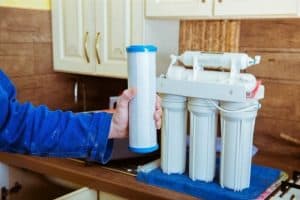
Advantages of Whole House RO Systems
Easy solution for the entire house: If the water supplied from the local area is poor, people should use water treatment solutions for their whole home.
This solution would meet different needs that include a shower filter under the kitchen sink water filter. Such a filter is meant for protecting almost every appliance in a house.
Buying separate filters would require maintenance and installation costs. So instead, it is better to go for a reverse osmosis filtration system for the whole house. This new filtration system would efficiently cover everything in the house.
Better water taste: After installing this system, the customer would consume water from any home faucet. The water being supplied in every system is not just pure but would also taste good.
This improvement in taste is mostly found due to elimination of unnecessary contaminants.
Those who prefer to drink water from bottles can save money and drink it from the reverse osmosis system.
Effective option: There is no other whole-house filtration system in the market as effective as Reverse Osmosis. These reverse osmosis systems can efficiently remove almost 99.9% of contaminants present in drinking water.
Therefore, it is always the best option if there is a requirement for standard whole home filters.
Increased lifespan of appliances: Appliances of a household like dishwashers and washing machines might get affected due to sulfur and iron deposits. The whole house reverse osmosis system can clean the water and improve the lifespan of water-based appliances.
Improve hair and skin health: Using water containing contaminants like calcium, manganese, and others can deteriorate the skin and scalp.
Besides, it might prove more harmful if a person lately suffers from any skin condition. A whole house reverse osmosis system would not just remove contaminants from the water but also help maintain healthy skin and hair.
Disadvantages of Whole House RO Systems
Expensive option: Whole house reverse osmosis systems are considered the most costly water treatment option for residential purposes. Keeping aside the initial costs spent on making the purchase, the system also requires maintenance and installation charges.
Changes in the reverse osmosis system like filter changes and replacement of essential parts are often needed.
This filtration system should not be purchased by those who do not tend to make long-term investments.
Might need pre or post-treatment: Whole house reverse osmosis systems usually require pre-or post-treatment that would help protect them and maintain the water’s high quality.
For example, if there is any need to install a water softener before the reverse osmosis system to prevent damage by hardness minerals, a neutralizing water filter is needed.
This neutralizing filter can efficiently remedy the high acidity and return the pH to neutral. A UV filter might be required if the customer wants to disinfect water that contains contaminants from the RO tank.
Reverse Osmosis water is a more potent solvent than would grab onto impurities like dissolved metals.
Wastage of water: One can find several whole house RO systems in the market that are more efficient than under-sink alternatives.
However, being more prominent and treating so much water daily might lead to the wastage of water by the RO filtration system. Even the toilet water and bathwater of a household are filtrated through this system.
The exact amount of water being wasted by the system would depend on the household’s amount of water every day.
More space required: Under-sink reverse osmosis systems without a tank have started gaining popularity in the market.
But it would not be feasible to purchase a whole house reverse osmosis system without any storage tank. This storage tank consists of a clean water supply to the faucet whenever needed.
But the problem with the RO system is the space needed by it. Without enough space in a garage or basement, the reverse osmosis system is not of much use.
Needs adequate water pressure: A PSI of at least forty is required for operating a whole house RO filtration system. If the PSI is lower than this, the user must purchase a pressure pump.
This pressure pump would be responsible for boosting the water pressure at the POE. The reverse osmosis process cannot operate if there is inadequate water pressure.
If the water pressure is shallow, enough water cannot be sent out through the filters. This is why it is advisable always to get the PSI checked.
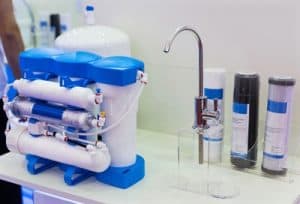
Things To Consider Before Purchasing a Reverse Osmosis System
Before purchasing a reverse osmosis system, one must consider certain important factors:
Source water chemistry: Water composition, including its pH level and several contaminants, plays a vital role in a person’s buying decision. If the water in a household is hard, they should first consider purchasing a water softener.
This would help ensure that the system has a long lifespan and that the RO membrane is protected.
Water with an unusually high or low pH can also damage the membrane. But this problem does not arise if the water comes from a municipal source. Still, getting the drinking water tests done in advance is advisable.
These tests are essential in understanding whether an inline pre-filter needs to be installed or not.
Installing the sediment filter, for example, can help in protecting the reverse osmosis membrane.
Water consumption: There are several RO systems available in the market from which customers can choose. The size of the system would depend on the level of water consumption.
The smallest reverse osmosis system is suitable for residential use. Daily consumption of water is essential in determining the flow rate that would be suitable. This can be done either by handy calculation or by a smart meter.
The water consumption level would be vital in understanding the storage tank size needed. Larger reverse osmosis tanks are required mostly for commercial purposes like in laundries.
The pressure of water and flow rate: As was mentioned earlier, residential homes usually have a water pressure of 40 PSI. This is just the minimum pressure needed for any RO system to operate.
But if the home has issues regarding its water pressure, there might be a need for a booster pump.
The booster pump would increase the home’s water pressure and ensure enough water is being flown through the reverse osmosis system.
Adequate water pressure is helpful as it helps an individual use multiple water-based appliances simultaneously.
Usually, such booster pumps are connected to some power source. Instruments like a pressure gauge can also be used to measure the pressure exerted by the water.
Frequently Asked Questions
How much does a whole house RO system cost?
The cost of whole house RO systems usually ranges from $12,000 to $18,000.
However, this cost might increase based on other factors like water generation every day, pre-filtration equipment needed, and others.
How long does a whole house reverse osmosis system last?
The average whole house reverse osmosis system can last up to fifteen to twenty years from installation.
But to keep the system in good condition, it is essential to maintain it properly. Protecting the system with additional filters can be helpful too.
How long does it take to install a whole house RO system?
Usually, it takes around four to five hours to install a whole house RO system.
Does reverse osmosis damage copper pipes?
Yes, reverse Osmosis does significant damage to copper pipes over the period. The water from this system is very pure and can leach out the minerals from the pipes.
Is reverse osmosis water healthy to drink?
No, the consumption of reverse osmosis water is not healthy. The low mineral content of this water can harm an individual in the long run.
Final Word
The reverse Osmosis system makes people’s regular life easier by filtering their water and helps in utilizing the wastewater.
The water that goes through this system is purified and it can be sent to a wastewater plant. This water can then be diluted and used in the treatment.
The reverse osmosis system has various benefits, including producing completely clean and purified water in the home.

